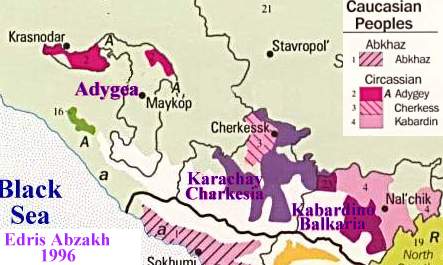Attempts at reducing the language to writing in the 19th and early 20th century had also failed .Circassian become a literary language only after the Russian revolution .The Circassians are Sunni of the Hanafi school who tend to be non-fanatical and among whom the Adat or custom low - The Adyge-Habze - has reminded extremely strong .It is the language and the custom law that have formed the chief component parts in Circassian tribal groups speaking numerous, bu t mutually intelligible dialects, were the main ethnic element in NW Caucasus .This changed drastically when under the pressure of the Russian conquest, especially after the defeat of the Great Revolt (1825-1864) a Circassian mass exodus - 'One of the gre atest mass movements of population in modern history ' (Henze , 1986) - took place to Turkey and other areas of the Ottoman Empire, including the Middle East .One and a half million Circassians abandoned their ancient homeland, leaving behind scattered remnant communities .The Russian census of 1897 recorded only 150,000 Circassians, less the one tenth of the original population .

|
|
The Adyge Autonomous Province, which since the collapse of the Soviet Union has declared i
tself an Autonomous Republic . The 125,000 or so Circassians-Adyge from about 22% of total
population.
This is the community covered by Bridges in this issue (these and the following figures are
based on the 1989 census; for a 1993 population estimate see Gammer, 1995) . |
|
The Karachai-Cherkess Autonomous Province, which also declared itself an autonomous
Republic.
The 52,000 or so Circassians-Cherkess are less than 10% of the population and officially
share the republic with the Karachais. |
|
The Kabardin-Balkar Autonomous Republic, the only unit where the 391,000 Circassians-Kabardins,
from almost 50% of the population, but they too share the republic with an unrelated people,
the Balkars. |
It was also under the Soviet regime that Circassian become a literary language, or rather two literary languages .Following the Soviet populist approach to language planning, the literary language was supposed to reflect as closely as possible the dialect spoken by the people .Therefore different alphabets were devised for the western Circassians-the Adyge, and for the central and western Circassians - the Cherkess and Kabardins (Isaev, 1979) . In the first two decades of the Soviet regime, tremendous language construction work was accomplished and the mother tongue began to play an important role in almost all domains, including education . however, in the late 1930s Soviet language policy began to shift away from the emphasis on the mother tongue.
In 1938 Russian was officially decreed a compulsory subject in all Soviet schools .In the last decades of the Soviet Union, outright promotion of Russian as the language of a new community - the new Soviet People, became the chief goal of Soviet language policy and many non-Russian languages, including Circassian in both it's varieties, were phased out of the school system as languages of instruction (Kreindler, 1982, 1989, 1995) .
The collapse of the Soviet Union has heightened Circassian national feeling both in Russia and in the Diaspora .Since the collapse, the Circassians have forged links with their brethren all over the world . The International Association of Circassian Peoples has organized world congresses in which Israeli delegations have taken a very active part .Among the issues raised are the need to revive the language in Russia and diaspora, the desirability of constructing a common literary language and a return to the Latin alphabet .
Estimated population of Circassians from all over the world
|
Special thanks to Isabelle Kreindler .
Rihania , Israel
1996